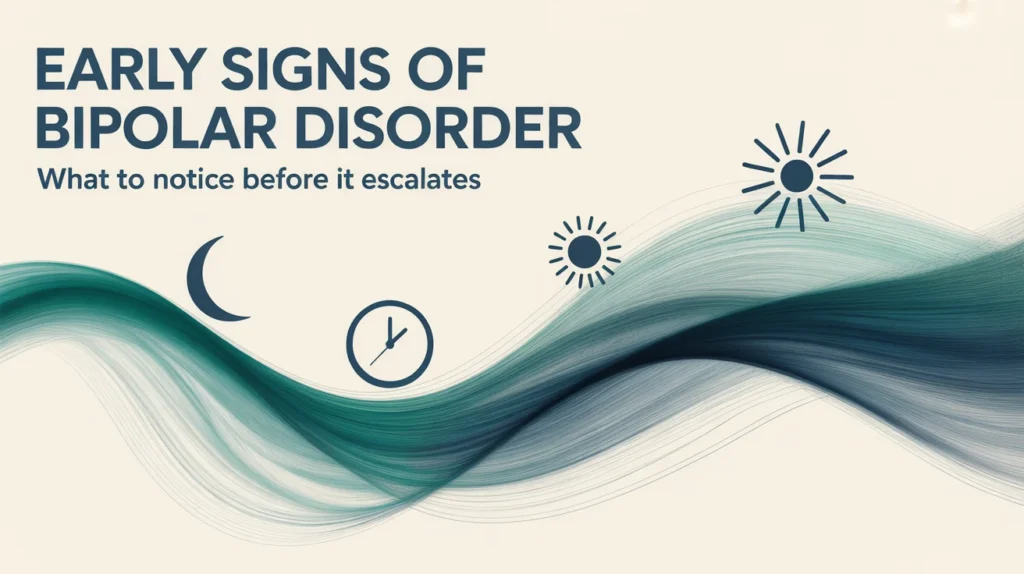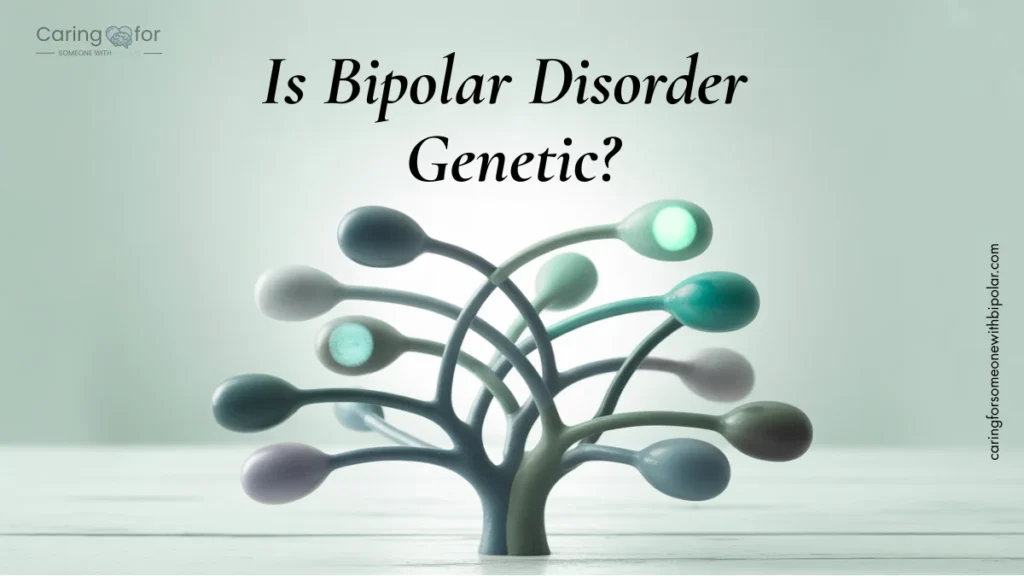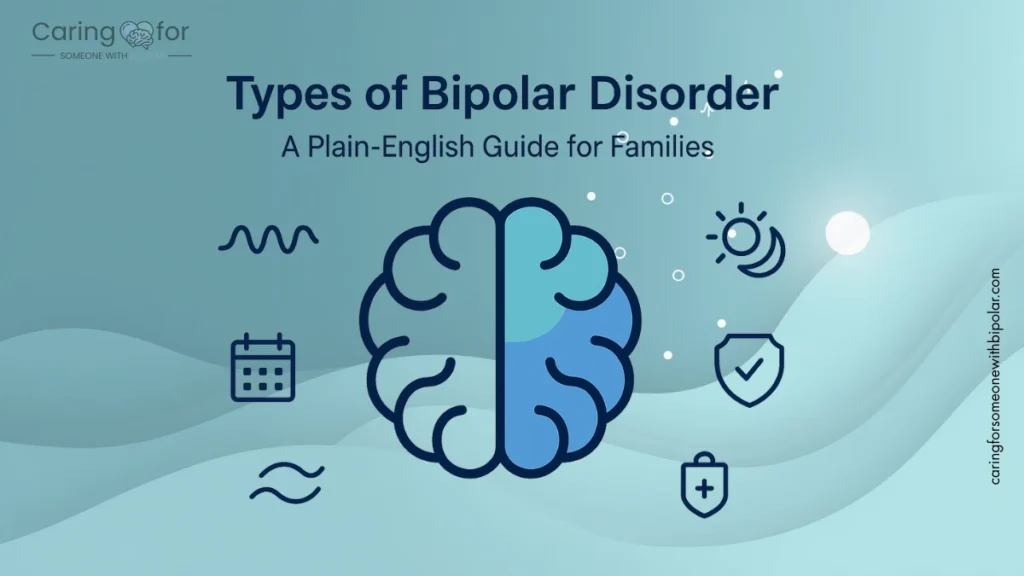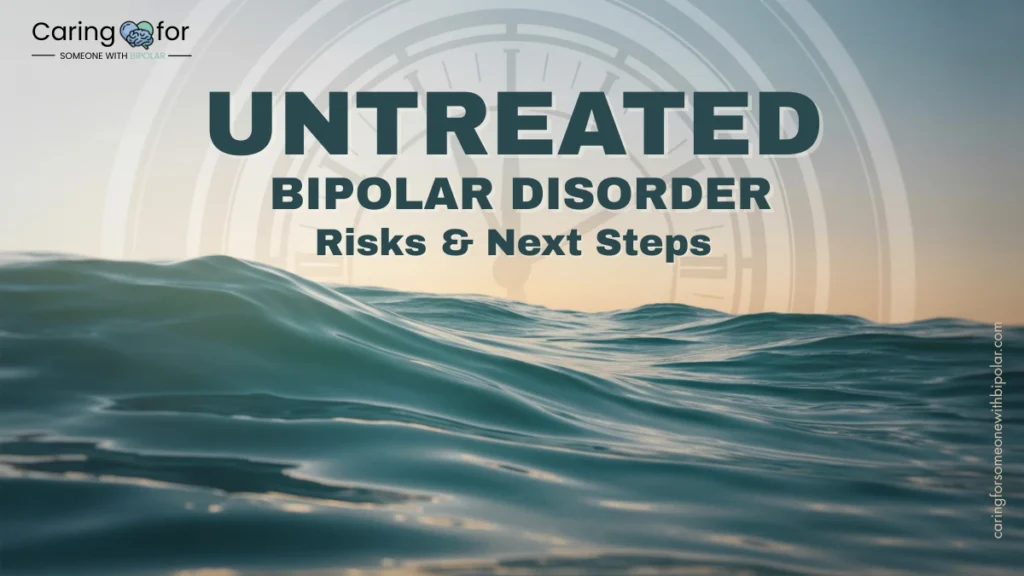Author: Elena – Caregiver Advocate
Medically reviewed by: Dr. L. Saadi, MD (Psychiatry) – Last reviewed: September 8, 2025
Educational information only; this article does not replace professional care.
Crisis support (non-monetized)
• U.S.: Call/text 988 (Suicide & Crisis Lifeline)
• U.K.: Samaritans 116 123
• International: Search the IASP crisis center directory
The early signs of bipolar disorder are often subtle, sleep changes, unusual energy, and mood shifts that look like stress or burnout. Spotting these patterns early can prevent years of confusion and misdiagnosis. In this guide, you’ll see how early hypomania differs from “high energy,” what early bipolar depression looks like, and why women’s symptoms are often missed. You’ll also learn when to seek a professional evaluation and how to support someone compassionately.
Early signs of bipolar disorder include: sleep changes (less or more), unusual energy, racing thoughts, mood swings, irritability, impulsive choices, and cycles of “high” periods followed by crashes. Track patterns over weeks – not single days – and seek a professional evaluation if symptoms persist.
Understanding these early symptoms is the first step toward compassionate support, better outcomes, and avoiding common misdiagnoses like depression, anxiety, or ADHD.
Why Early Detection Matters
Catching bipolar disorder early can drastically improve long-term outcomes. According to the Mayo Clinic and NHS, early intervention reduces the risk of severe manic episodes, self-harm, and major life disruption. Unfortunately, many people go years undiagnosed, especially if their symptoms don’t match the more dramatic stereotypes.
Bipolar II disorder, which is more common in females, often begins with prolonged depressive episodes, making it easy to confuse with major depression. Others may show signs of hypomania that are dismissed as high energy or ambition. Without the right context, the early signs are easily overlooked or mislabeled.
A timely diagnosis allows for:
- Stabilizing mood before a major manic or depressive episode
- Reducing risk of substance abuse and hospitalization
- Supporting healthier relationships, schooling, or work performance
If you’re asking yourself: “Is bipolar disorder curable?”, the short answer is no. But it is highly manageable, especially when caught early and treated with a combination of medication, therapy, and lifestyle adjustments.
How Bipolar Disorder Typically Begins
Bipolar doesn’t suddenly appear overnight. For many, it starts with what psychologists call a prodromal phase, a period where early behavioral or emotional signs begin to surface before full criteria for bipolar are met.
In this phase, you might notice:
- Changes in sleep habits (sleeping much more or much less)
- Fluctuating energy levels without clear cause
- Trouble focusing or staying emotionally regulated
- Mood shifts that feel “off” but aren’t extreme
Because these symptoms can mimic common life stressors or other conditions (like ADHD or generalized anxiety), it’s common for the onset of bipolar disorder to go unnoticed, sometimes for years.
These early signs may surprise you. For instance, what looks like creativity, productivity, or intense passion might actually be a form of hypomania, especially if followed by periods of exhaustion or depression.
Next, let’s explore how these symptoms differ in the early stages of mania vs. depression.
Early Signs of Mania and Hypomania
Not all “high energy” is healthy, and in bipolar disorder, that’s especially true. The early signs of mania or hypomania can feel empowering at first. But underneath the surface, they often reflect an unstable and escalating shift in brain chemistry.
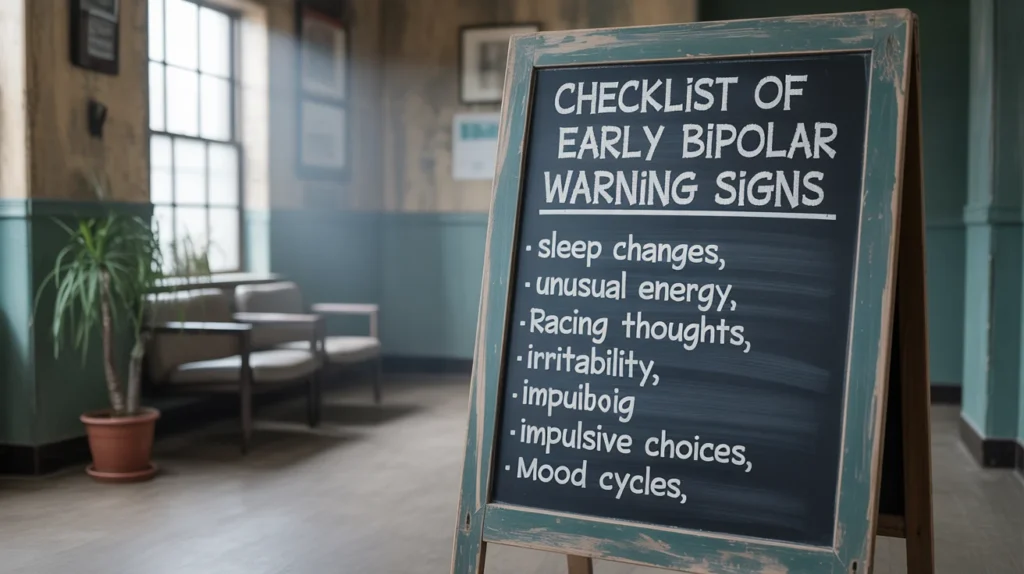
What is Hypomania?
Hypomania is a milder form of mania and is common in Bipolar II disorder, especially in females. Unlike full mania, hypomania doesn’t usually involve psychosis or hospitalization. In fact, it’s often mistaken for a “productive phase”, which can make it dangerously easy to ignore.
Common Early Manic and Hypomanic Symptoms
- Increased energy or activity — You may notice someone working late into the night, talking excessively, or suddenly taking on multiple projects with urgency.
- Reduced need for sleep — They feel rested after only 2–3 hours, often without feeling tired the next day.
- Racing thoughts — Their mind feels “on fire,” jumping rapidly from idea to idea.
- Elevated or irritable mood — It may look like extreme confidence, impatience, or even aggression.
- Impulsivity — Risky spending, sudden travel, or unexpected decisions can appear without warning.
- Grandiosity — Believing they can do things far beyond their skill or resources.
These behaviors often get misread as confidence, drive, or even genius, especially in teens and young adults. But when these early signs of bipolar disorder appear in patterns, they’re strong indicators that something deeper is unfolding.
Why It’s Often Missed in Females
Many females with bipolar disorder symptoms experience hypomania that is more emotional than dramatic, marked by anxiety, irritability, or restlessness instead of euphoria. This can lead to misdiagnosis as generalized anxiety or even borderline personality disorder.
Understanding these subtleties is essential to avoid delayed diagnosis, especially in adolescents.
Early Signs of Bipolar Depression
In many cases, especially in Bipolar II disorder, the first symptoms to appear aren’t manic, but depressive. That’s why bipolar is often misdiagnosed as major depressive disorder, especially in its early stages. But bipolar depression tends to be more intense, more recurrent, and more resistant to standard antidepressant treatment.
Recognizing the early signs of bipolar depression can help prevent years of emotional pain and inappropriate care.
Key Symptoms to Watch For
- Persistent sadness or hopelessness – This goes beyond feeling “down” and often includes emotional numbness.
- Low energy and extreme fatigue – They may seem “slowed down” physically and mentally.
- Loss of interest in normal activities – Hobbies, socializing, and even eating may lose their appeal.
- Changes in sleep patterns – Sleeping too much or struggling with insomnia are both common.
- Difficulty concentrating – Thoughts may feel foggy, indecisive, or stuck in a loop.
- Irritability or restlessness – Especially in teens, depression may appear as anger or defiance.
- Feelings of guilt or worthlessness – Self-esteem may plummet without clear cause.
- Suicidal thoughts – These must always be taken seriously, even in the absence of other symptoms.
Important Note:
Unlike unipolar depression, bipolar depression often alternates with hypomanic or manic episodes, even if those are subtle. If your loved one cycles between sadness and periods of high energy or impulsivity, it’s worth speaking to a mental health professional about the possibility of bipolar disorder.
For more insight, see: [What Does Untreated Bipolar Really Look Like?]
📌 What are the first signs of bipolar disorder?
The first signs of bipolar disorder often include sudden mood swings, unusual energy levels, sleep changes, and emotional sensitivity. Early symptoms can look like bursts of creativity or motivation followed by fatigue or sadness. Tracking these patterns early can help identify bipolar before full manic or depressive episodes occur.
Gender-Specific Patterns: Bipolar Symptoms in Females
While bipolar disorder affects all genders, research shows that females often experience different symptom patterns compared to males, especially in the early stages. These differences can delay diagnosis or lead to mislabeling, which makes it crucial for supporters and clinicians to recognize what bipolar might look like in women.
More Likely to Experience Bipolar II
Studies suggest that Bipolar II disorder is more common in females, often presenting with longer and more intense depressive episodes. Since Bipolar II lacks full-blown mania, many women are incorrectly diagnosed with unipolar depression or anxiety, missing the hypomanic episodes that would confirm a bipolar diagnosis.
Hormonal Triggers and Mood Sensitivity
Hormonal changes can influence bipolar symptoms in females, including:
- PMS or PMDD worsening mood episodes
- Postpartum depression evolving into bipolar onset
- Perimenopause/menopause affecting stability
These hormonal fluctuations can trigger early bipolar symptoms or intensify existing ones, particularly mood swings, sleep disturbances, or emotional reactivity.
Emotional Presentation Differences
In many cases, early bipolar symptoms in women show up as:
- Heightened anxiety or internal restlessness
- More irritability than euphoria during hypomania
- Emotional hypersensitivity, especially in relationships
What to Watch For
If you notice a pattern of:
- Depression alternating with high energy or restlessness
- Unpredictable mood swings that don’t align with external events
- Emotional intensity that comes in waves
… it may be worth exploring the possibility of bipolar disorder symptoms in females, even if traditional criteria don’t seem to apply.
Use a mood/sleep tracker to surface patterns across weeks; share objective notes with clinicians to avoid misattribution. (This section avoids medicalized claims about hormones unless your reviewer adds perinatal specifics.) (nhs.uk)
When and How Bipolar Disorder Often Starts
One of the most misunderstood aspects of bipolar disorder is its timing. Many people assume it’s an adult-onset condition, but in reality, bipolar disorder often begins in adolescence or early adulthood, sometimes as early as age 12. These early signs can appear subtly and gradually, making it hard for even close family members to detect what’s really going on.
Typical Age of Onset
- Most people are diagnosed between the ages of 15 and 25.
- However, symptoms often appear years before a formal diagnosis.
- For some, the earliest signs can begin in childhood as mood instability, impulsivity, or difficulty regulating emotions.
What Early Onset Can Look Like
In young people, the early symptoms of bipolar disorder can be masked by normal developmental changes, such as moodiness, rebellion, or identity shifts. But there are red flags to watch for:
- Mood swings that are extreme, unpredictable, and interfere with school or relationships
- Periods of elevated mood followed by crashes (e.g., bursts of creativity or energy followed by days in bed)
- Sleep patterns that dramatically change, such as staying up all night without fatigue
- Behavior that cycles between impulsivity and withdrawal
How Early Can Bipolar Be Diagnosed?
Psychiatrists typically don’t diagnose bipolar disorder until late adolescence, unless the symptoms are severe and meet full criteria. That said, early signs should still be taken seriously. Keeping a mood diary, documenting behavioral patterns, and involving a mental health professional early can help clarify whether it’s emerging bipolar disorder or something else, such as depression or ADHD.
Causes and Contributing Factors of Bipolar Disorder
While the exact cause of bipolar disorder isn’t fully understood, research shows it’s the result of a complex combination of genetic, biological, psychological, and environmental factors. Understanding what contributes to bipolar onset can help families recognize risk factors early — especially if mood symptoms are already beginning to show.
Genetics and Family History
The most well-established risk factor is family history. If one parent has bipolar disorder, a child has about a 10–25% chance of developing it. If both parents are affected, that risk increases significantly.
This doesn’t mean bipolar is inherited like eye color, but genetic vulnerability plays a key role in shaping how someone responds to life stress, sleep disruption, and emotional stimuli.
Related read: [Is Bipolar Disorder Genetic? What Science Says]
Brain Chemistry and Biology
Brain imaging studies show that people with bipolar disorder often have differences in:
- Neurotransmitter regulation (e.g., dopamine, serotonin)
- Prefrontal cortex activity (affecting judgment and impulse control)
- Amygdala reactivity (linked to emotional response)
These brain differences are believed to affect how mood shifts are processed and regulated, especially during times of stress or transition.
Environmental Stress and Trauma
Life events, especially during childhood or adolescence, can contribute to the onset of bipolar symptoms, including:
- Abuse or neglect
- Loss of a parent or caregiver
- Chronic stress or bullying
- Substance use (especially cannabis or stimulants)
These don’t “cause” bipolar disorder by themselves but may act as triggers in genetically vulnerable individuals.
Testing and Diagnosis: How Bipolar Disorder Is Identified
There’s no single blood test or brain scan to confirm bipolar disorder. Instead, diagnosis relies on a thorough evaluation of behavioral patterns, mood history, and clinical criteria. For someone showing early symptoms, timely assessment is key to avoid misdiagnosis, especially as bipolar disorder is often mistaken for unipolar depression, ADHD, or borderline personality disorder.
How Is Bipolar Disorder Diagnosed?
Mental health professionals follow the DSM-5 (Diagnostic and Statistical Manual of Mental Disorders) guidelines, which outline specific criteria for mania, hypomania, and depression. A diagnosis typically requires:
- At least one manic (or hypomanic) episode
- A history of depressive episodes
- Symptoms that significantly impair daily functioning
What to Expect During an Evaluation
A psychiatric evaluation may include:
- A structured clinical interview
- Family history of mood disorders
- A mood diary or symptom tracker (to identify patterns over time)
- Psychological assessments (e.g., Bipolar Spectrum Diagnostic Scale)
You may also be offered a bipolar disorder test or quiz as a screening tool, though this is not a diagnosis on its own.
Common Challenges in Early Diagnosis
- Bipolar II disorder is often mistaken for depression, especially in females.
- Hypomanic episodes can go unnoticed or be perceived as “productive” phases.
- Symptoms in teens may be written off as hormonal or behavioral.
That’s why early signs and symptoms of bipolar disorder should be tracked and discussed with a mental health professional, even if they don’t yet meet the full criteria.
FAQs: Early Signs of Bipolar Disorder
Conclusion: Pay Attention Early, Act with Compassion
Bipolar disorder doesn’t just arrive overnight, it unfolds gradually, often beginning with signs that are easy to dismiss or misinterpret. Whether it starts with unexpected energy surges, intense sadness, irritability, or sleep disruption, the key is to notice patterns, not just episodes.
If you or someone you love is showing early signs and symptoms of bipolar disorder, don’t wait for things to escalate. Tracking behaviors, consulting a mental health professional, and seeking proper evaluation early can change the course of the condition, leading to better treatment outcomes and more stable relationships.
What to Do Next
- Start a mood diary to track fluctuations.
- Reach out to a psychiatrist or therapist if patterns persist.
- Learn the different types of bipolar disorder to understand how symptoms evolve.
Explore next: [Types of Bipolar Disorder Explained]
Or return to our full guide: [How to Support Someone With Bipolar Disorder]

